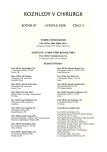The Dependence of Weight Loss on the Dimensions of Neoventriculus in Patients after Gastric Banding
Authors:
A. Foltýs; J. Dostalík; L. Martínek
Authors‘ workplace:
Chirurgická klinika Fakultní nemocnice Ostrava, přednosta: doc. MUDr. Jan Dostalík, CSc.
Published in:
Rozhl. Chir., 2008, roč. 87, č. 11, s. 567-570.
Category:
Monothematic special - Original
Overview
Background:
At present the surgical procedure is accepted in the physicians’ opinion of the cases of morbid obesity in patients where the conservative therapy has failed. Bariatric surgery offers an effective, standardized, and safe way to radical and long-term loss of weight. The laparoscopic gastric banding is the most frequent procedure in patients with morbid obesity.
Aim of the study:
The aim of the study was to consider if the statistic dependence exits between the weight loss and the dimensions of neoventriculus in patients after gastric banding or between the weight loss and the width of artificial stenosis created operatively.
Methods:
One hundred and eighty four patients with morbid obesity underwent the laparoscopic gastric banding from January 1, 2001 to July 30, 2006. The dimensions of neoventriculus and the width of artificial stenosis were measured after the operation. The patients were divided into three subgroups according to the dimensions of neoventriculus and the width of artificial stenosis. The patients were followed 2 years and the weight loss was registred. The results were statistically evaluated by correlative ratio.
Results:
The correlative ratio were calculated between weight loss and the dimensions of neoventriculus and between the weight loss and the width of artificial stenosis created operatively. The analysis showed that there was no statistic difference between the tested parameters.
Conclusions:
The study has showed that the success of gastric banding does not depend on the dimensions of neoventriculus and on the width of artificial stenosis but it depends on orderliness of patients. It means the adherence of dietary limitations and recommandations.
Key words:
obesity – body mass index – bariatric surgery – gastric banding – dimensions of neoventriculus
Sources
1. American Association of Bariatric Surgery. 100 SW 75th Street, Suite 201 Gainesville, FL 23607 (U.S.A.) (on line): Guidelines for Granting Privileges in Bariatric Surgery 2003, dostupný na www:/http:// www.asbs.org/html/guidelines.html
2. Hainer, V. Obezita dosahuje rozměrů celosvětové epidemie. Lék. Listy, 2004, 22, p. 10.
3. Abu-Abeid, S., Keidar, A., Gavert, D., et al. The clinical spectrum of band erosion following laparoscopic adjustable silicone gastric banding for morbid obesity. Surg. Endosc., 2003, 17, p. 861–863.
4. Fried, M., Pešková, M., Kasalický, M. Bariatric surgery at the 1st surgical department in Prague: History and some technical aspects. Obes. Surg., 1997, 7, p. 22–25.
5. Fried, M., Pešková, M., Kasalický, M. Assessment of the outcome of laparoscopic nonadjustable gastric banding and stoma adjustable gastric banding: Surgeons‘ and patients‘ view. Obes. Surg., 1998, 8, p. 45–48.
6. Král, J. in Guy – Grand, B. (ed).: Management of obesity and overweight. Background paper prepared by the IOTF‘s Obesity Management Subgrup 1996.
7. Consensus Statement, NIH Consensus Development Conference, March 25–27, 1991, Bethesda, MD, USA.
8. Hellers, G., Forsell, P. The Swedish adjustable gastric banding (SAGB) for morbid obesity: weight loss and complication in up to a 10-year-follow-up. Obes. Surg., 1997, 7, p. 301–302.
9. Sucharda, P., Šonka, J., Pešková, M. Indikace chirurgické léčby otylosti: Čas. Lék. Čes., 1987, 126, 27, p. 844–846 (in Czech).
10. Oria, H. E. Gastric banding for morbid obesity. Eur. J. Gastroenterol-Hepatol. 1999, 11, p. 105–114.
11. Dargent, J. Laparoscopic surgery in morbid obesity: adjustable – ring gastroplasty. Ann. Chir., 1999, 53, p. 467–471.
12. Mason, E. E. Vertical banded gastroplasty for obesity. Ann. Surg., 1982, 117, p. 701.
13. Thornley, S. J., Windsdor, J. A. The role of surgery in the management of obesity. N. Z. Med. J., 1998, 111, p. 445–448.
14. Colquitt, J., Clegg, A., Sydhgu, M., Royle, M. Surgery for morbid obesity. Cochrane database of systematic reviews (electronic resource) 2003, (2), p. CD003641.
15. Sjostrom, L. Reduction in incidence of diabetes, hypertension and lipid disturbances after international weight loss induced by bariatric surgery: the SOS Intervention Study, Obes. Res., 1999, 69, p. 373.
16. Mun, E. C., Blackburn, G. L., Matthews, J. B. Current status of medical and surgical therapy for obesity. Gastroenterology, 2001; 120 : 669–681.
17. Kasalický, M, Michalský, D. Chirurgická léčba morbidní obezity. Prakt. Lék., 2004; 84, No. 5: p. 273–278.
Labels
Surgery Orthopaedics Trauma surgeryArticle was published in
Perspectives in Surgery

2008 Issue 11
- Metamizole vs. Tramadol in Postoperative Analgesia
- Metamizole at a Glance and in Practice – Effective Non-Opioid Analgesic for All Ages
- Metamizole in perioperative treatment in children under 14 years – results of a questionnaire survey from practice
Most read in this issue
- The Use of Biodegradable Materials in the Management of Bone Cysts in Children
- Biliary Ileus – Potential Complication of Cholecystolithiasis
- Operation Treatment of the Humeral Shaft Fractures
- Minimally Invasive Surgery in the Czech Republic
